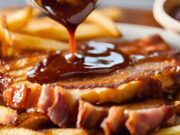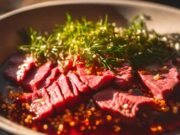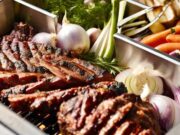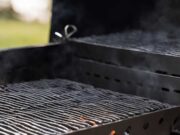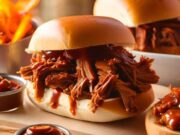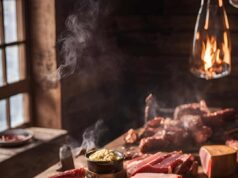Grilling transcends mere cooking; it represents a celebration of flavors, community, and tradition.
Whether you are preparing to fire up the grill for a backyard gathering or a straightforward weeknight dinner, mastering the art of BBQ can significantly enhance your culinary skills and leave a lasting impression on your friends and family.
This guide is tailored for beginners and is filled with essential tips, techniques, and safety advice to help you confidently navigate the grilling process.
From selecting the appropriate equipment to perfecting your cooking methods, you are about to ignite your passion for outdoor cooking.
Key Takeaways:
- Invest in quality grilling equipment and understand the different types of grills (gas, charcoal, electric) to achieve the best results.
- Proper preparation is key: let ingredients rest, use marinades and rubs, and trim excess fat for enhanced flavors.
- Master the technique by preheating the grill, handling food properly, and learning how to grill vegetables and fruits.
Mastering the Grill: Essential BBQ Tips and Tricks for Beginners
Mastering the grill is an essential skill for anyone seeking to elevate their outdoor cooking experience, particularly in the realm of barbecue (BBQ). Grilling provides an enjoyable opportunity to gather family and friends, fostering cherished memories over perfectly cooked meats and delectable dishes.

By understanding the right techniques, equipment, and safety measures, you can enhance your grilling prowess and ensure that every cookout becomes a delicious success. From managing temperatures to selecting high-quality ingredients, there is a wealth of grilling knowledge to explore that will transform your outdoor gatherings into unforgettable culinary experiences.
What is Grilling?
Grilling is a cooking technique that involves applying direct heat to food, typically over an open flame or hot coals. This method results in a unique flavor and texture that many individuals enjoy during cookouts. It is well-known for creating delicious, juicy meats and vegetables, allowing their natural flavors to shine through, particularly when enhanced with marinades and seasonings.
Various grilling techniques, such as direct grilling, indirect grilling, and smoking, enable you to tailor the process to different types of cuisine, whether you are preparing a classic American barbecue or a zesty Mediterranean feast. The range of tools available, from charcoal and gas grills to portable electric models, provides versatility to those who practice this culinary art.
Proteins like steak, chicken, and seafood benefit significantly from this method, as the high heat caramelizes sugars on the surface, creating enticing sear marks. Vegetables also thrive on the grill, with their flavors intensifying and textures becoming delightfully charred.
The Joy of BBQ: Why Everyone Should Master the Grill
The joy of BBQ lies not only in the delicious flavors that emerge from the grill but also in the experiences you share with family and friends during outdoor gatherings. Mastering the grill enables you to create memorable moments that bring people together, allowing them to savor the smoky aromas and flavors of well-cooked dishes while enjoying the warmth of the summer sun.
The laughter shared over grilled favorites, the stories exchanged between bites, and the anticipation built as the grill sizzles are truly irreplaceable. As you become adept at various cooking techniques, such as smoking or searing, you elevate the backyard cooking experience, allowing for diverse and mouth-watering meals that cater to everyone’s palate.
These gatherings transcend mere food; they foster deeper emotional connections as individuals bond over their love for good BBQ. Engaging in this communal activity under the open sky inspires a sense of belonging and celebration, creating lasting memories that endure long after the last bite is taken.
Essential Grilling Equipment
Investing in quality grilling equipment is essential for achieving the perfect cookout experience. The right tools can greatly enhance your grilling skills and improve the overall quality of the food.
Whether you opt for a gas grill for convenience or a charcoal grill for that classic smoky flavor, understanding the different types of equipment available will enable you to elevate your BBQ game and impress your guests with delicious, expertly cooked meals.
1 | Invest in Quality Grilling Equipment
Investing in quality grilling equipment is essential for your success as a grill master. High-quality tools can significantly impact your ability to achieve perfectly cooked meats and vegetables. Whether you opt for a gas or charcoal grill, selecting reliable grilling tools such as spatulas, tongs, and brushes will set the stage for delicious BBQ experiences.
Certain tools enhance your cooking efficiency and safety, ensuring that you make the most of your grill. For example, a good meat thermometer, like those from ThermoWorks, takes the guesswork out of cooking, allowing you to ensure that meats are cooked to perfection. Additionally, heat-resistant gloves will protect your hands from burns, adding another layer of safety to your grilling process.
A sturdy grilling basket is also invaluable, as it allows for even cooking of smaller items like vegetables or shrimp, preventing them from falling through the grates. Brands like Weber and Cuisinart provide reliable products that focus on performance, durability, and ease of use, ensuring that both novice and experienced grillers can enjoy an immaculate grilling experience.
2 | Understanding Different Grill Types: Gas, Charcoal, and Electric
Understanding the differences between various grill types—gas, charcoal, and electric—can significantly assist you in making an informed decision when selecting the best equipment for your cooking style. Each grill type offers unique features that cater to different preferences, from the convenience of a gas grill to the traditional smoky flavor produced by charcoal, ensuring that your BBQ sessions are both enjoyable and efficient.
If you prioritize quick setups and easy temperature control, a gas grill is often the favored option. It provides consistent heat and allows for instant ignition, making it a popular choice among busy cooks. On the other hand, charcoal grills are well-regarded for their ability to infuse meats with a rich, smoky flavor; however, they typically require longer cooking times and more attention to maintain the desired temperature.
Electric grills offer a straightforward and low-maintenance alternative, especially suitable for urban settings where outdoor space may be limited. Each grill type presents distinct advantages and challenges, ultimately shaping your overall experience of outdoor cooking.
Preparing for the Grill
Properly preparing for the grill is a crucial step in the grilling process, ensuring that your ingredients are primed to create mouthwatering dishes that will impress your family and friends.
From selecting high-quality meat and fresh vegetables to marinating ingredients for enhanced flavor, dedicating time to preparation not only increases the deliciousness of your BBQ but also contributes to food safety during cooking.
3 | Let Ingredients Rest Before Grilling
Allowing ingredients to rest before grilling is a crucial step that can significantly enhance the quality and flavor of your dishes, particularly with meat. Bringing meat to room temperature ensures even cooking and improves the retention of juices, resulting in a tender and juicy final product that will impress your guests.
This practice also minimizes cooking time, as the meat won’t require extra minutes on the grill to reach the desired doneness. Furthermore, it contributes to achieving a better sear, allowing the exterior of the meat to brown beautifully and develop layers of flavor that elevate the overall dish.
Resting ingredients can also reduce the risk of dryness, ensuring that every bite remains flavorful and succulent. By adopting this straightforward yet effective technique, you can transform your grilling experience, making each meal not only satisfying but also memorable.
4 | Marinades and Rubs: Enhancing Flavors
Utilizing marinades and rubs is an effective strategy for enhancing the flavors of your grilled dishes, as these techniques infuse the ingredients with deliciousness that elevates the overall taste. Marinades, which typically consist of oil, acids, and seasonings, can tenderize meat while adding depth of flavor, making them essential for any grill master aiming to impress guests.
Marinades not only unlock a wide range of flavor possibilities, but rubs also play a crucial role in transforming your preferred meats into truly mouthwatering meals. A well-crafted rub generally combines spices, herbs, and other seasonings to create a savory crust when grilled.
Popular choices for marinades often include ingredients such as soy sauce, garlic, fresh herbs, and citrus juice, while rubs may feature paprika, cumin, or even brown sugar for a touch of sweetness.
For a straightforward marinade, consider mixing olive oil with lemon juice, minced garlic, and rosemary, allowing the meat to soak for at least an hour. Similarly, a basic rub can be made by combining equal parts salt, pepper, and your favorite dried herbs.
These techniques not only enhance flavor but also contribute to the beautiful caramelization that draws diners to the grill.
5 | Trimming Excess Fat: Why It Matters
Trimming excess fat from meat before grilling is a crucial practice that not only enhances the safety of your dishes but also improves their overall flavor and texture. By removing an excessive layer of fat, you can reduce flare-ups on the grill, which often lead to burnt areas and uneven cooking. This process allows you to create tender, juicy meat that showcases its natural flavors.
A well-trimmed piece of meat cooks more evenly, ensuring that every bite is delicious and perfectly done. It’s important to consider the type of meat you are working with; for instance, when preparing pork chops, trimming around the edges helps eliminate chewy bits of fat that do not render well during cooking. Similarly, for cuts like brisket, removing some fat can enhance its texture while still retaining enough intramuscular fat to keep it flavorful.
Remember to use a sharp knife and make smooth strokes to prevent tearing the meat, ensuring that your final dish is both safe and appetizing.
Mastering the Technique
Mastering the technique of grilling is essential for any aspiring grill master, as proper technique can significantly influence the outcome, distinguishing perfectly cooked, juicy meat from a dry, overcooked disaster.
This mastery involves understanding key factors such as temperature management, cooking times, and the appropriate use of tools. Each of these elements contributes to a successful outdoor cooking experience that will impress family and friends alike.
6 | Preheat Your Grill for Perfect Cooking
Preheating your grill is a critical step that sets the stage for perfect cooking, ensuring that your food sears beautifully and locks in all the delicious juices. By allowing your grill to reach the desired temperature before placing your ingredients on the grates, you create the optimal environment for achieving that coveted smoky flavor and juicy texture characteristic of grilled dishes.
Not only does preheating enhance the searing process, but it also shortens overall cooking time, enabling you to prepare meals efficiently without compromising on quality. For gas grills, a preheat time of 10-15 minutes is generally sufficient, while charcoal grills may require around 20-30 minutes to reach the desired heat. Electric grills can often be ready in about 5-10 minutes.
By keeping these timeframes in mind, you can boost the flavors, ensure that your food is cooked evenly, and reduce the chances of sticking. Embracing this vital step in the grilling process can significantly elevate your culinary experience.
7 | Handling Food Properly: Avoid Piercing
Handling food properly while grilling is crucial for maintaining the integrity of the ingredients and ensuring that the natural juices remain intact. One important technique is to avoid piercing the meat with forks or other sharp tools, as doing so can release valuable juices that contribute to the overall flavor and tenderness of the finished dish.
Instead, you should utilize tongs or a spatula to flip and maneuver items, preserving moisture and enhancing the barbecue experience. Allowing proteins to rest briefly after grilling promotes the redistribution of juices, ultimately leading to a more succulent bite. Knowing when to flip—typically when the meat naturally releases from the grill grates—can also make a significant difference.
By mastering these best practices, you not only boost flavor but also improve the texture of grilled foods, resulting in a juicy, perfectly cooked meal that will impress at any gathering.
8 | Tips for Grilling Vegetables and Fruits
Grilling vegetables and fruits is an excellent method for enhancing their natural flavors while introducing a delightful smoky char that can elevate any dish. To achieve optimal results, it is important to select high-quality, fresh ingredients and employ specific techniques, such as cutting them to the appropriate size and applying marinades, to ensure even cooking and the development of rich flavors.
Timing is essential in grilling; denser vegetables like bell peppers and zucchini typically require about 5-7 minutes per side, whereas softer options, such as asparagus or mushrooms, may only need 3-5 minutes.
To maximize flavor enhancement, consider tossing the produce in a mixture of olive oil, herbs, and spices before grilling. This approach not only adds depth but also helps prevent sticking.
For fruits like pineapples and peaches, grilling them for approximately 2-3 minutes on each side allows their natural sugars to caramelize beautifully, creating a delicious contrast with the smoky notes from the grill.
It is crucial to keep a close eye on everything to avoid overcooking, ensuring that you achieve the best possible results.
Cooking and Safety Tips
Cooking and safety tips are crucial elements of a successful grilling experience. Taking the proper precautions ensures that your delicious BBQ remains safe for everyone to enjoy.
It is important to understand key safety guidelines, such as cooking meat to the appropriate temperature and practicing good hygiene. By following these practices, you protect both yourself and your guests while simultaneously savoring the delightful flavors of your grilled dishes.
9 | Ensuring Your Food is Cooked Through
Ensuring that your food is thoroughly cooked is a critical aspect of grilling that significantly affects both flavor and safety. Undercooked meat can result in foodborne illnesses, while overcooked dishes may become dry and unpalatable. Utilizing a reliable thermometer to check internal temperatures is an effective method to ensure that your meats, such as steak and ribs, are cooked to perfection while prioritizing safety.
For example, the recommended cooking temperature for ground beef is a minimum of 160°F, while chicken should reach at least 165°F to effectively eliminate harmful bacteria. Pork, which is often overlooked, should be cooked to a safe internal temperature of 145°F and allowed to rest for three minutes to ensure that juices redistribute.
By adopting the practice of using a thermometer, you can eliminate guesswork and ensure that every bite is not only delicious but also safe to consume, making your grilling experience stress-free and enjoyable.
10 | Allowing Meat to Rest After Cooking
Allowing meat to rest after cooking is a crucial step that ensures maximum flavor and juiciness in your grilled dishes. By letting the meat sit for a few minutes before slicing, you enable the juices to redistribute throughout the cut, resulting in tender, flavorful bites that will impress your guests.
Different types of meat benefit from varying resting times to achieve optimal results. For instance, smaller cuts like chicken breasts and pork chops should rest for about 5-10 minutes, while larger cuts such as steaks and roasts can benefit from a longer period of 10-20 minutes. This waiting period is essential, as it prevents the juices from spilling out when the meat is cut, enhancing both the texture and overall taste.
As the meat cools slightly, the fibers relax, leading to a more succulent and enjoyable eating experience. By prioritizing the resting phase, you can transform simple grilled dishes into gourmet offerings.
11 | Fire and Grill Safety Tips
Fire and grill safety tips are essential for ensuring a safe and enjoyable grilling experience, particularly during outdoor cookouts where flames and heat are present. By adhering to key safety practices, such as closely monitoring the grill and having a fire extinguisher readily available, you can significantly reduce the risk of accidents while fully enjoying delicious grilled foods.
Proper grill placement is critical for maintaining safety; ensure that the grill is situated away from flammable materials such as wooden decks, overhanging branches, or dry grass. Regularly monitoring the flames and ensuring they remain contained is vital to prevent unexpected flare-ups, which could lead to accidents.
Being prepared for emergencies is also crucial. Always have a spray bottle filled with water or a fire blanket nearby, as these items can effectively address small fires before they escalate. Educating everyone involved about these safety practices will greatly contribute to a safer and more enjoyable grilling environment.
Perfecting Your Craft with Practice and Passion
Perfecting your grilling skills is a journey that demands dedication, practice, and a genuine passion for outdoor cooking. As you explore different techniques, flavors, and ingredients, you will refine your abilities and cultivate a deeper appreciation for the art of BBQ, transforming each cookout into a delightful experience for your family and friends.
Embarking on this flavorful adventure allows you to experiment with various meats, marinades, and spices, each contributing its unique twist to your culinary repertoire. Whether it’s the smokiness of cherry wood or the zest of citrus-infused rubs, every grilling session presents an opportunity to unlock new dimensions of taste.
Engaging with fellow enthusiasts, attending local BBQ competitions, or simply watching tutorial videos can further enhance your knowledge and inspire your creativity. The satisfaction derived from mastering grilling techniques not only elevates your gatherings but also fosters a true sense of community among food lovers who share your enthusiasm for outdoor cooking.
Frequently Asked Questions
What are some essential BBQ tips for beginners?
Some essential BBQ tips for beginners include investing in a quality grill, properly cleaning and maintaining your grill, and using the right tools and equipment for grilling.
How do I know when my grill is ready to use?
The best way to know when your grill is ready to use is by preheating it for at least 10-15 minutes. You can also test the heat by holding your hand about 6 inches above the grate – if you can only keep it there for a few seconds, the grill is hot and ready.
What are some common mistakes to avoid when grilling?
Some common mistakes to avoid when grilling include not properly preheating the grill, constantly flipping the food, and not properly seasoning the food. It’s also important to not overcrowd the grill and to keep a close eye on the food to prevent burning.
What type of fuel should I use for grilling?
The type of fuel you use for grilling depends on personal preference and the type of grill you have. Charcoal is a popular option for its smoky flavor, while gas is convenient and easy to use. Some grills also offer the option to use both.
How can I prevent food from sticking to the grill?
To prevent food from sticking to the grill, make sure your grill is clean and well-oiled before cooking. You can also brush oil onto the food itself before placing it on the grill. If using a marinade, make sure to pat the food dry before grilling to prevent excess moisture and sticking.
What are some essential tools for mastering the grill?
Some essential tools for mastering the grill include a spatula, tongs, grill brush, meat thermometer, and heat-resistant gloves. Depending on the type of food you are grilling, other tools such as skewers, a basting brush, and a grill basket may also be helpful.








